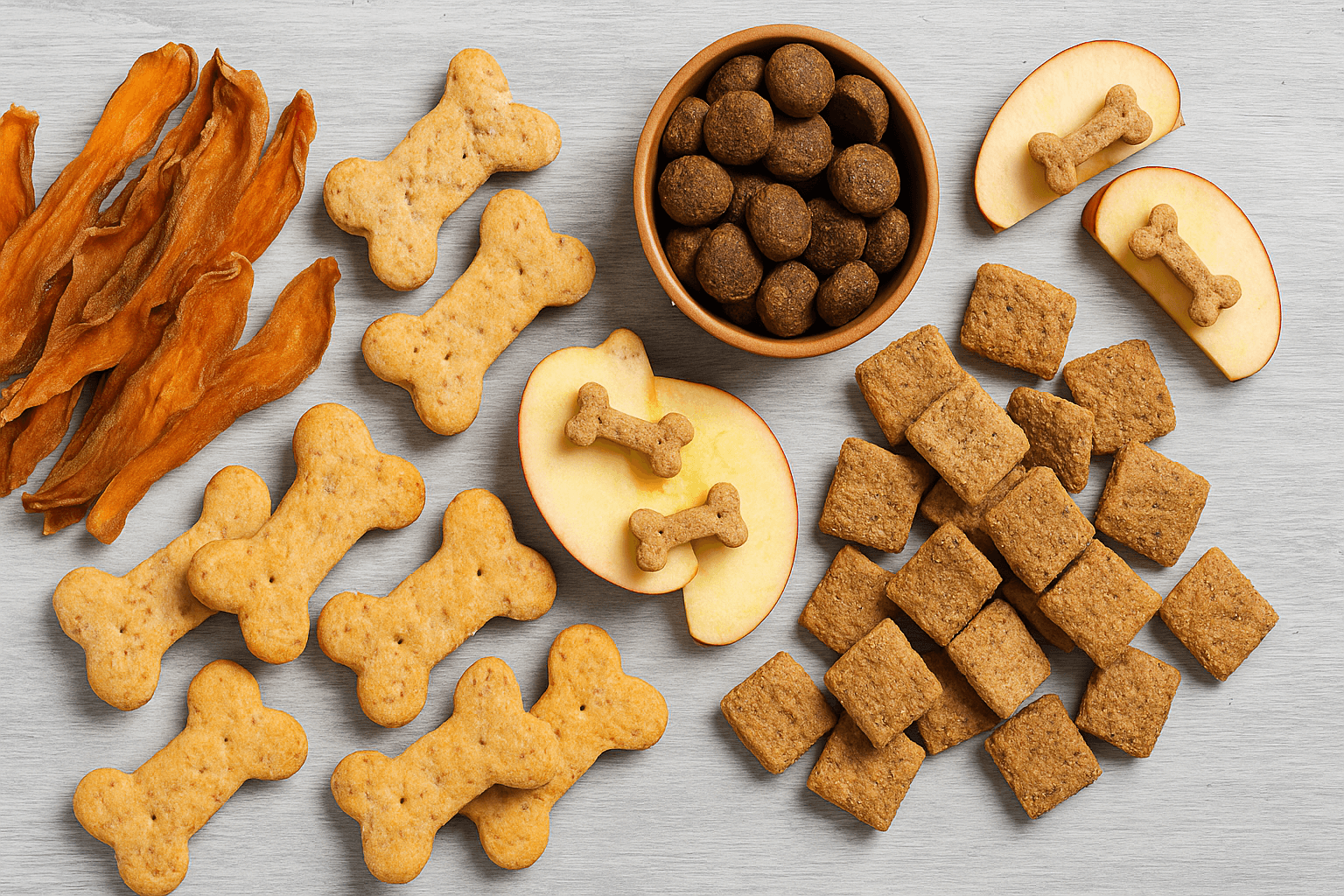Whether you're training your new puppy or spoiling your senior pup, healthy dog treats can be a tasty (and guilt-free) way to show love. But with so many options on the market—grain free, high protein, organic—how do you pick the right one?
As a certified pet blogger and dog mom to a food-sensitive Labrador named Olive, I’ve tested dozens of treats. Let’s sniff out the best options together!
🥕 Why Healthy Dog Treats Matter
Just like us, dogs thrive on clean, balanced diets. Choosing natural dog treats can support your pup’s energy levels, digestion, and even skin health.
- Fewer fillers: Less junk, more nutrients.
- Better digestion: Especially for dog treats for sensitive stomachs.
- Weight control: Thanks to low calorie dog treats.
🍖 Top Vet-Approved Dog Treats (That Taste Amazing)
- Riley’s Organic Dog Treats
Organic, crunchy, and USDA-certified. Great for daily training. - Zuke’s Mini Naturals
Perfect low calorie dog treats for repetitive training sessions. - Wholesome Pride Sweet Potato Bites
Single-ingredient natural dog treats with no added junk. - The Honest Kitchen Beams
High protein dog treats made from dehydrated fish skin. Olive’s favorite! - Blue Buffalo Wilderness Trail Treats
Grain free dog treats packed with protein. - Blueberries
These small berries are loaded with antioxidants and Vitamin C, making them a healthy and easy snack. - Campfire Treats Beef Liver
These are all-natural, single-ingredient, high-protein treats made from premium U.S. beef, with no additives or preservatives. - Pureed Pumpkin (Cooked or Canned)
Rich in fiber and vitamins, pumpkin is excellent for aiding digestion and can be used as a seasonal treat. Always use plain, unsweetened pumpkin. - Fresh Carrot Slices
Low in calories and packed with beta-carotene, carrots are great for dental health and eyesight. Cut into appropriate, bite-sized pieces to prevent choking. - Plain Cooked Chicken Breast
A high-reward, lean protein source that's gentle on most stomachs and promotes healthy skin and coat. Ensure it's plain, boiled, and unseasoned.
🍪 Homemade Dog Treats You Can Make at Home
Want to whip up some homemade dog treats? Here’s a simple, vet-approved recipe I use when Olive’s tummy acts up:
Ingredients: 1 cup pumpkin purée, 2 eggs, 2 ½ cups oat flour, 1 tbsp coconut oil. Mix, roll out, cut, and bake at 350°F for 25 mins.
These are gentle on sensitive stomachs and super fun to make with kids!
✅ Treats for Dogs with Sensitive Stomachs
For pups like Olive, dog treats for sensitive stomachs are a must. Look for:
- Limited ingredients – Fewer allergens
- Single-protein treats – Like salmon or turkey
- No artificial colors or preservatives
Brands like Hill's Science Diet Soft Baked and Natural Balance L.I.D. are great go-tos.
📋 Feeding Guidelines: Do’s and Don’ts
- Do use treats as part of training or enrichment.
- Don’t give more than 10% of daily calories in treats.
- Do monitor for allergies or digestive issues.
- Don’t substitute treats for balanced meals.
🎯 How to Pick the Best Healthy Treats for Dogs
Here’s what to sniff out when choosing the best healthy treats for dogs:
- Look for labels like “organic,” “human-grade,” and “grain-free” if needed.
- Check protein sources – duck, salmon, lamb are great options.
- Size matters – Small bites are best for training.
🗂️ Quick Comparison: Best Healthy Dog Treats (2025)
| Treat | Main Ingredient | Best For | Calories |
|---|---|---|---|
| Riley’s Organic | Peanut Butter | Daily rewards | 17/treat |
| Zuke’s Mini Naturals | Chicken | Training | 3/treat |
| Wholesome Pride | Sweet Potato | Allergy-friendly | Low |
🐾 Final Woof
Whether you're buying organic dog treats or baking your own, the key is simple: read labels, know your pup’s needs, and don’t be afraid to experiment (responsibly!). Treats are more than snacks—they’re moments of joy between you and your dog.
And if you’re looking for even more pup-approved content, follow along—we’re always sniffing out new ways to help you love your dog better. 🐶💛
Frequently Asked Questions (FAQs)
1. What are the healthiest dog treats?
2. Can I give homemade treats to my dog every day?
3. Are grain free dog treats better?
4. What treats are best for training puppies?
5. How do I know if a treat is vet approved?
6. What treats should I avoid for dogs?

About SniffnTail
SniffnTail is your go-to destination for everything pets. From helpful advice, tips, and insights to thoughtfully selected products and resources, we’re here to support pet owners at every stage of their journey. Whether you're caring for a playful pup, a wise old cat, or anything in between, SniffnTail offers tools and knowledge to make pet parenting easier and more joyful.
Related Articles
 Nutrition • 5 mins Read
Nutrition • 5 mins ReadThe Best Dog Food by Breed: A Comprehensive Guide
Feeding your dog a diet tailored to its breed can significantly enhance its health, energy, and longevity. Different breeds have unique needs due to their size, metabolism, activity level, and genetic predispositions. Here is a detailed guide to the best types of food for various dog breeds
 Nutrition • 5 mins Read
Nutrition • 5 mins ReadCoconut Oil for Dogs: Benefits, Uses & Safety Tips Every Pet Parent Should Know
Coconut oil has made its way from kitchen shelves to wellness routines—and now, it’s a rising star in the world of pet care. If you’re a dog parent wondering whether coconut oil is good for dogs, the short answer is yes—but with some precautions. This natural remedy has gained popularity for its range of potential health benefits, from shiny coats to digestive support.
 Nutrition • 7 min read
Nutrition • 7 min readIs Feeding Dogs Once a Day a Good Idea? Here's What Vets and Experts Say
Wondering if feeding your dog once a day is healthy? Discover the pros, cons, and expert advice on once-daily feeding for dogs, plus tips on meal timing and dog digestion.

